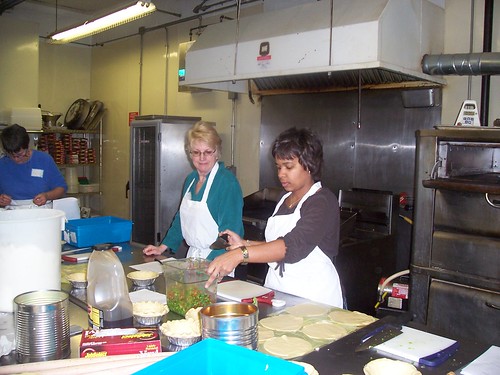
Despite the fiasco that was The Oyster Incident of 2008, I ventured forth and took another cooking class (#247) with two of my favorite colleagues, CJ (Left) and Bubbles (R). This class was “Pot Pies & Meat Pies” and it was deliciously fun. We made little pot pies full of all kinds of goody goodness (salmon, clams, ground beef, etc.) and then we ate some of our creations (including an empanada-like fried dish) and made some home-made potato chips! Yum.
Hi Dia,
It has been awhile since I have posted a message but coming back to read your entries have made me laugh out loud. I miss you like a crazy woman misses her sanity (or does she, if she’s crazy she wouldn’t know it was missing now would she). I hope you are finding warmer climates, unburnt stoves, free wine, and and good friends to share all of your adventures with.
Big Hug & Love,
Shayla Snack
HAPPY BIRTHDAY!!!!

What is Money?
The answer to the question is simple. Money is anything widely used for paying debts owed by a person to someone else and also for receiving the payments of debts owing to a person from someone else. A country produces coins and banknotes, (accepted by everyone) for the payment of bills and for the receipt of money owing.
Money is what is known as a “medium of exchange”.
In the “old days” people traded the goods and services they owned (and probably produced) for goods and services owned by others (probably produced by them). The scenario went something like this – “you give me two sacks of your potatoes and I will trade you ten of my fish”.
This method of trading was fine for a while. As society developed, business became more cumbersome and inefficient with this method of trade. Business dealings became stilted and slow and lagged behind the new pace of commerce. There had to be a better way. Some bright spark then came up with the idea of a common “medium of exchange” easier to carry around and better to use.
Money was born.
It wasn’t that simple, because while all sorts of things were used as a medium of exchange, these were all basically called “money” and it wasn’t until coins and paper notes were developed that money as we know it today became the standard accepted as a medium of exchange.
Forms of Money
There are various forms of money – cheques, IOU’s, credit cards, bank drafts or gold. Gold was the standard used in the past because of its scarcity and its qualities. Gold is resistant to corrosion or damage. These unique properties, as well as the scarcity of gold means that even today, wealthy people around the world would rather keep their wealth in gold holdings than in the currencies of countries which are subject to inflation.
In fact, all sorts of things have been used as money throughout the ages. Some include: beads, eggs, salt, pigs, leather, yarn, axes, ivory and jade. Today we have another form of money, which cannot be touched, and yet it as real as the tangible coins we are able to touch. This form of money is electronic money.
The Name “Money”
The word money comes from the Roman goddess – Moneta. Apparently coins were minted in her temples and issued to the world, as the Romans knew it at the time. The Latin word “Moneta”, (meaning mint or coins) came from the old English word “mynet” (meaning coins or money) and from this came the English word “mint”.
Origins of Money
To understand the origins of money we have to go back to a time well before money came on the scene. Money did not suddenly appear – it was introduced gradually in response to the requirements of human needs. As civilization grew and expanded beyond local societies, the need to exchange the products provided by various groups became evident. The hunter needed to exchange with the farmer, the shepherd needed to exchange with the medicine man etc.
The medium of exchange that was necessary to enable the various groups to barter and swap their products was money. It was originally a physical substance like gold or silver. Sometimes it was a substance that was alive such as cattle, which was one of the oldest forms of money.
Today, although much of the money used by individuals in their everyday life is still in the form of notes and coins, its quantity is relatively small compared to the intangible types of money existing as entries in bank records.
Today money exists in the form of digital cash and such things as coins and bank notes will soon become obsolete. When this happens, the change in the nature of money will have a significant effect on our society.
Moncler Menuire Down Jacket in White MC10062